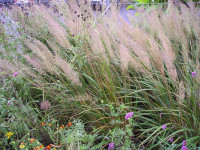Grasses are enjoying a great vogue now in the gardening world, and deservedly so. The interest in more ecologically focused home landscapes, naturalistic planting styles and native plant materials are all paths that lead to the more widespread and intelligent use of these vitally important plants.

Large grasses like this variegated Miscanthus (here with Lespedeza thunbergii ‘Gibraltar’) hold their own in a mixed border of shrubs and large scale perennials.
Most grasses are sun-loving creatures, coming as they do from the prairies, steppes, and meadows of the world. But there are forest grasses too, and grassy textured sedges for shadier sites. Texture is one of the main reasons to plant grasses… they just look so wonderful next to anything with bold or clumpy foliage, softening the picture and lending grace to stodgier plants.
Movement is another big reason to use them… nothing moves in the breeze as well as grasses, and their rustle is as soothing to the ear as their swaying is to the eye. Variety is another reason… there are so many different heights, textures and color variations among just the grasses in common cultivation that the choice can be bewildering. Here at Pondside we carry at least a dozen species and cultivars at any given time, and we can help you select the most appropriate choice for your needs.

Shade tolerant grasses and sedges provide a linear texture that contrasts well with the broad leaves of many shade plants. In the background is Variegated Japanese Forest Grass, Hakonechloa macra ‘Aureola’. In the foreground, Bowles’ Golden Sedge, Carex elata ‘Aurea’.
There are the Miscanthus in great variety, from the twelve-foot ‘Giganteus’ to the refined, fine-textured ‘Graziella’. There are the Panicums, American natives that produce spectacular heads of airy bloom that are enchanting when backlit by the late summer sun. Calamagrostis are another fantastic tribe, their flowering like stalks of grain (C. x ‘Karl Foerster’) or soft foxtail plumes (C. brachytricha). Plus Pennisetums, Schizachyriums, Sorghastrums, Sporobolus, Hakonechloas, and many more. The names may seem a bit intimidating, but the plants are easy to grow and so rewarding.

Sorghastrum nutans ‘Sioux Blue’, a selection of our native Indian grass, looks right at home in naturalistic plantings.
We always have a selection on hand, but we really stock up on them after midsummer, when the flowering perennials have mostly come and gone. The grasses will please you all through the rest of the season, ripening into fall, and even standing up to the first snows, a welcome reminder of the warmth and richness of the summer past.


